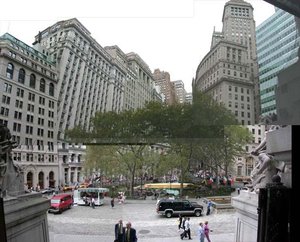Bowling Green (New York City)
|
|
Bowling Green is a small public park in Lower Manhattan at the foot of Broadway next to the site of the original Dutch fort. It is the oldest existing public park in New York City. At the present time, it is probably most known for being the location of the sculpture Charging Bull.
| Contents |
Description
The park is a wedge-shaped plaza, formed by the convergence of Whitehall Street and Broadway, of which the park forms the southern terminus. A portion of the park is a fenced-in grassy area with tables and chairs that are popular lunchtime destinations for local workers in the nearby Financial District.
The south end of the plaza is bounded by the front entrance of Alexander Hamilton US Custom House, which currently houses the New York branch of the National Museum of the American Indian.
History
The park has long been an epicenter of activity in the city going back the days of New Amsterdam in the 17th century, when it served as cattle market and parade ground.
In 1733, the local government laid out a bowling green and offered it for rent to three local residents for one peppercorn a year.
In August 21, 1770, the British government erected a 4,000 pound gold-plated leaden statue in the plaza depicting King George III mounted on horseback and dressed in Roman garb in the style of the Equestrian Statue of Marcus Aurelius. The statue had been commissioned in 1766, along with a statue of William Pitt, to the prominent London sculptor Joseph Wilton.
The statue was very unpopular with the public. In 1773, the city passed an anti-graffiti and anti-desecration law to counter vandalism against the monument. On July 9, 1776, after the Declaration of Independence was read to Washington's troops at the current site of City Hall, a mob of local citizens rushed to Bowling Green where they toppled the statue. The event is considered one of the most enduring images in the city's history. According to folklore, the statue was chopped up and shipped to a Connecticut foundry to be made into some 40,000 Patriot bullets. Parts of the statue are preserved in the New-York Historical Society. The event has depicted over the years in several works of art, including an 1859 painting by artist Johannes Adam Simon Oertel.
New_York_Charging_Bull_Sculpture.jpg
Following the Revolution, elegant townhouses were built around the park, which became largely the private domain of the residents. By 1850, the general northward migration of residences in Manhattan led to the conversion of the residences into the shipping offices, resulting in full public access to the park.
The park suffered neglect after World War II, but was restored by the city in the 1970s and is now one of the most heavily traveled plazas in the city.
In 1989, the sculpture Charging Bull was installed in the park by the New York City Department of Parks and Recreation after it had been confiscated by the police following its illegal installation on Wall Street. The sculpture has become one of the beloved and recognizable landmarks of the Financial District.
Subway Station
Bowling Green is also the name of a New York City Subway station on the IRT Lexington Avenue Line, the entrances of which are located in and next to the plaza.
See also
External links
- Where is King George's head? (http://www.ctssar.org/articles/king_georges_head.htm)
- Abandoned Stations: Bowling Green (http://www.columbia.edu/~brennan/abandoned/bowling.html)

